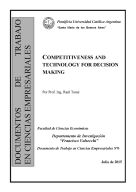Please use this identifier to cite or link to this item:
https://repositorio.uca.edu.ar/handle/123456789/2383| Título: | Competitiveness and technology for decision making | Autor: | Tomé, Raúl | Palabras clave: | MERCADOS; COMPETITIVIDAD; EMPRESAS; TIPO DE CAMBIO; EXPORTACIONES; ADMINISTRACION DE EMPRESAS | Fecha de publicación: | 2015 | Editorial: | Universidad Católica Argentina. Facultad de Ciencias Económicas. Departamento de Investigación "Francisco Valsecchi" | Cita: | Tomé, R. (2015, julio). Competitiveness and technology for decision making [en línea] Documento de trabajo en Ciencias Empresariales No. 6 del Departamento de Investigación “Francisco Valsecchi”. Facultad de Ciencias Económicas. Universidad Católica Argentina. Disponible en: https://repositorio.uca.edu.ar/handle/123456789/2383 | Resumen: | Introducción: It is usually accepted that the exchange rate and the possibility to export are strongly related. This means that the revaluation of the currency of an exporting country regarding to another importing country’s currency, leads to a deterioration of the capacity of producers of the exporting country to export goods and services into the destination country; and vice versa, that a devaluation helps to export. It is also usual, associate easiness to penetrate a market with the concept of competitiveness. That means to say that competitiveness of the local producers of the exporter country worsens or it improves respectively due to the commented changes in the exchange rate. This is not so certain. Competitiveness of an industry is defined as a capacity: the capacity to defend the market share of the industry in a local market; and to penetrate new external markets, in absence of subsidies or duty barriers that can distort the reading. That plainly means the competitiveness of a sector is strongly determined by intrinsic characteristics of this sector in comparison with similar ones of its direct foreign competitors. In strict sense the competitiveness of an industry is associated to its scale, localization, productivity, quality, innovation, commitment, image, and others, factors all them decisive for the competitiveness, that are usually fixed up or down through other short term based factors, as the exchange rate, the duty rate or other mechanisms - commercial, sanitarium, normative - to mention to the most transparent and healthy ones- or even those implying quotas, local registration, or previous approval, among the more harmful. | URI: | https://repositorio.uca.edu.ar/handle/123456789/2383 | Disciplina: | ADMINISTRACION DE EMPRESAS | Derechos: | Acceso Abierto | Fuente: | Documento de Trabajo en Ciencias Empresariales nº 6, 2015 |
| Appears in Collections: | DTCE 2015 |
Files in This Item:
| File | Description | Size | Format | |
|---|---|---|---|---|
| competitiveness-technology-tome.pdf | 544,83 kB | Adobe PDF |  View/Open |
Page view(s)
314
checked on Dec 12, 2025
Download(s)
124
checked on Dec 12, 2025
Google ScholarTM
Check
This item is licensed under a Creative Commons License

